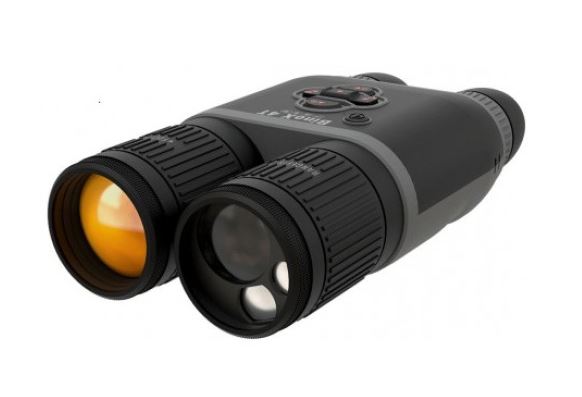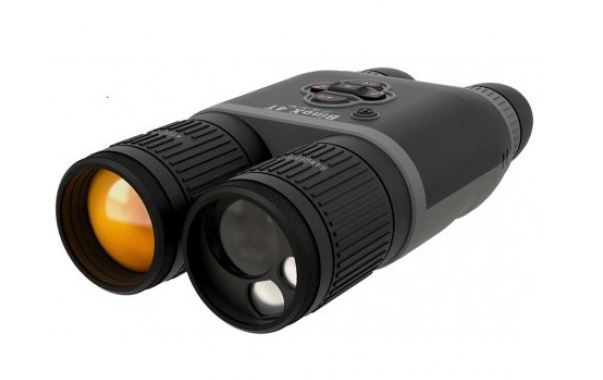Products:
https://www.optics-trade.eu/en/vortex-viper-hs-2-5-10×44.html
https://www.optics-trade.eu/en/vortex-viper-hs-4-16×44.html
https://www.optics-trade.eu/en/vortex-viper-hs-4-16×50.html
This text is a transcription of the file in PDF format.
Specifically designed for the most discriminating hunters and shooters,
the Vortex®Viper®HS™ series of riflescopes offer the highest levels of
performance and reliability. With features such as 4x optical zooms,
generous long eye relief, and ruggedly constructed, single-piece main
tubes. The Viper HS riflescopes are ready for any situation.

Reticle Options
The Focal Plane
All riflescope reticles can be termed either first focal plane (FFP) or
second focal plane (SFP), depending upon their internal location within
the riflescope. This model features the second focal plane design.
Second Focal Plane Reticles
Second focal plane (SFP) reticles are located near the scope’s eyepiece
behind the image erecting and magnifying lenses. This style of reticle
does not visually change in size when you change the magnification.
The advantage of an SFP reticle is that it always maintains the same
ideal visual appearance.
Listed reticle subtensions used for estimating range, holdover, and wind
drift correction are accurate at the highest magnification. Note: Listed
BDC reticle subtensions for a 6–24×50 model are accurate with the
magnification set at 18x.

Riflescope Adjustments
Reticle Focus
The Viper HS riflescopes use a fast focus eyepiece designed to quickly and
easily adjust the focus on the riflescope’s reticle.

To adjust the reticle focus:
• Look through the riflescope at a
blank white wall or up at the sky.
• Turn the eyepiece focus knob in or
out until the reticle image is as crisp
as possible.
• Note: Try to make this particular
adjustment quickly, as the eye will try
to compensate for an out-of-focus reticle.
Once this adjustment is complete, it will not be necessary to re-focus
every time you use the riflescope. However, because your eyesight may
change over time, you should re-check this adjustment periodically.
Warning
Looking directly at the sun through a riflescope, or any optical instrument,
can cause severe and permanent damage to your eyesight.
Windage and Elevation Adjustments
The Viper HS riflescope incorporates adjustable elevation and windage
turret dials with audible clicks. Each audible click moves the bullet’s pointof-impact 1/4 of a minute of angle (MOA).
1/4 MOA closely corresponds to 1/4 inch at 100 yards, 1/2 inch at 200
yards, 3/4 inch at 300 yards—taking four (4) clicks to move the bullet’s
point-of-impact approximately one inch at 100 yards.

To make adjustments:
1. Remove the outer covers.
2. Turn the turret in the appropriate
direction: Up/Down or Left/Right as
indicated by the arrows.
3. Following the directional arrows, turn the
dials in the direction you wish the bullet’s
point-of-impact to go to.
Note: After sight-in, you can re-align the zero marks on the turret dials
with the reference dots if you wish (see Indexing Adjustment Dials with
Zero Reset on page 12). Replace outer covers when done.
Variable Power Adjustments
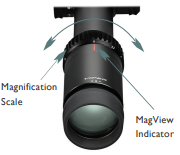
To change the magnification,
turn the magnification ring to the
desired level. The Vortex fiber
optic magnification indicator will
provide a low light reference for
magnification level.
Using the Side Focus
Select Viper HS riflescopes use a side focus adjustment which provides
maximum image sharpness and eliminates parallax error. The Viper HS
2.5–10×44 riflescopes do not use side focus adjustments and are pre-focused
at a distance of 100 yards.
Setting the side focus:
1. Be sure the reticle is correctly focused (see Reticle Focus on page 5).

2. Turn the side focus knob until the
target image is as sharp as possible. The
yardage numbers referenced on knob
should closely match the actual yardage
to the target.
3. Check for parallax error by moving
your head back and forth while looking
through the scope. The focus is correct if
there is no apparent shift of the reticle on the target. If you notice any shift, adjust the focus knob slightly until all shift is eliminated.
Parallax is a phenomenon that results when the target image
does not quite fall on the same optical plane as the reticle
within the scope. When the shooter’s eye is not precisely
centered in the eyepiece, there can be apparent movement of
the target in relation to the reticle, which can cause a small
shift in the point of aim. Parallax error is most problematic
for precision shooters using high magnification.
Riflescope Mounting
To get the best performance from your Viper HS riflescope, proper
mounting is essential. Although not difficult, the correct steps must be
followed. If you are unsure of your abilities, it would be best to use the
services of a qualified gunsmith.
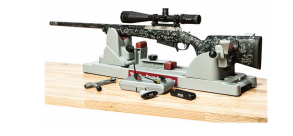
Rings and Bases
Mount an appropriate base and matching rings to your rifle according to
the manufacturer’s instructions. Viper HS riflescopes require 30 mm rings.
Use the lowest ring height that will provide complete clearance of scope
and rifle—avoiding any contact with barrel, receiver, bolt handle or any
other part of the rifle. A low mounting height will help assure proper
cheek weld, aid in establishing a solid shooting position, and promote fast
target acquisition.
Eye Relief and Reticle Alignment
After installing the bottom ring halves on the mounting base, place the
riflescope on the bottom ring halves and loosely install the upper ring
halves. Before tightening the scope ring screws, adjust for maximum eye
relief to avoid injury from recoil:
Eye Relief and Reticle Alignment
1. Set the riflescope to the middle of its magnification range.
2. Slide the riflescope as far forward as possible in the rings.
3. While viewing through the riflescope in a normal shooting
position, slowly slide the riflescope back towards your face. Pay
attention to the field of view. Stop sliding the riflescope back as soon
as you see the full field of view.
4. Without disturbing the front-back placement, rotate the riflescope
until the vertical crosshair exactly matches the vertical axis of the
rifle. Use of a reticle leveling tool, a weight hung on a rope, flat feeler
gauges, or a bubble level will help with this procedure.
After aligning the reticle, tighten and torque the ring screws down per the
manufacturer’s instructions.

Bore Sighting
Initial bore sighting of the riflescope will save time and money at the range.
This can be done in a number of ways. A mechanical or laser bore sighter
can be used according to the manufacturer’s instructions. On some rifles,
bore sighting can be done by removing the bolt and sighting through the
barrel.
To visually bore sight a rifle:
• Place the rifle solidly on a rest and remove the bolt.
• Sight through the bore at a target approximately 100 yards away.
• Move the rifle and rest until the target is visually centered inside the
barrel.
• With the target centered in the bore, make windage and elevation
adjustments until the reticle crosshair is also centered over the target.
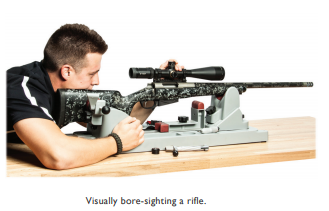
Final Range Sight-In
After the riflescope has been bore-sighted, final sight-in should be done at
the range using the exact ammunition expected to be used while shooting.
Sight in and zero the riflescope at the preferred distance. 100 yards is the
most common zero distance, although a 200 yard zero may be preferred for
long range applications.
Note: Be sure the reticle is in focus (see Reticle Focus on page 5) and set
the side focus adjustment (if present) to match the distance being used
for sight-in:
• Following all safe shooting practices, fire a three-shot group as precisely
as possible.
• Next, adjust the reticle to match the approximate center of the shot
group (see Windage and Elevation Adjustment on page 6).
Note: If the rifle is very solidly mounted and cannot be moved, simply look
through the scope and adjust the reticle until it is centered on the fired
group.
• Carefully fire another three-shot group and see if the bullet group is
centered on the bullseye.
This procedure can be repeated as many times as necessary to achieve a
perfect zero.
Indexing Adjustment Dials with Zero Reset
Viper HS riflescopes feature windage and elevation dials that will allow
you to re-index the zero indicator after sight-in without disturbing
your settings. This allows you to quickly return to your original zero
if temporary corrections are used in the field. Index the windage and
elevation dials in this way:
1. Remove the outer cap and pull the adjustment dial outward
against the spring tension until it stops.
2. With the dial pulled fully outwards, rotate the dial to reposition
the zero mark on the index line.
3. Release the dial, allowing it to return to the normal inward
position.

Maintenance
Cleaning
The fully waterproof and fogproof Viper HS riflescope requires very little
routine maintenance other than periodically cleaning the exterior lenses.
The exterior of the scope may be cleaned by wiping with a soft, dry cloth.
When cleaning the lenses, be sure to use products, such as the Vortex Fog
Free cleaning products or LensPen, that are specifically designed for use on
coated optical lenses.
• Be sure to blow away any dust or grit on the lenses prior to wiping the
surfaces.
• Using your breath, or a very small amount of water or pure alcohol, can
help remove stubborn things like dried water spots.
Lubrication
All components of the Viper HS riflescopes are permanently lubricated, so
no additional lubricant should be applied.
Note: Other than removing the turret caps, do not attempt to disassemble
any components of the riflescope. Disassembling of riflescope may void
warranty.
Storage
If possible, avoid exposing your Vortex riflescope to direct sunlight or any
very hot location for long periods of time.
Troubleshooting
Sighting-in Problems
Many times, problems thought to be with the scope are actually mount
problems. Be sure that correct base and rings are being used in the correct
orientation, and that the base screws and rings are tight. Insufficient
windage or elevation adjustment range may indicate problems with rings,
base, base alignment, base mount holes drilled in the rifle’s receiver, or
barrel/receiver alignment.
Check for Correct Base and Ring Alignment
• Roughly center the reticle by adjusting both windage and elevation
turrets to the mid point of their travel ranges.
• Attach bore sighter, or remove bolt and visually boresight rifle.
• Look through the scope. If the reticle appears way off center on the
boresighter image or when compared to the visually centered target when
looking through rifle’s bore, there may be a problem with the bases or rings
being used. Confirm that correct base and rings are being used—and in the
proper orientation.
Tips for Solving Bullet Grouping Problems
• Maintain a good shooting technique and use a solid rest.
• Check that all screws on rifle’s action are properly tightened.
• Be sure rifle barrel and action are clean and free of excessive oil or
copper fouling.
• Check that rings are correctly torqued per the manufacturer’s instructions.
• Some rifles and ammunition don’t work well together—try
different ammunition and see if accuracy improves.
The VIP Warranty
We build optics based on our commitment to your absolute satisfaction.
That’s why Vortex products are unconditionally guaranteed and we make
this Very Important Promise to you—a Very Important Person.
Rest assured that in the event your Viper HS riflescope becomes damaged
or defective, Vortex Optics will repair or replace
the riflescope at no charge to you. Call Vortex
Optics at 800-426-0048 for prompt, professional,
and friendly service.

Vortex Optics
2120 West Greenview Drive
Middleton, WI 53562
[email protected]
Note: The VIP warranty does not cover theft, loss, or deliberate damage
to the product.
